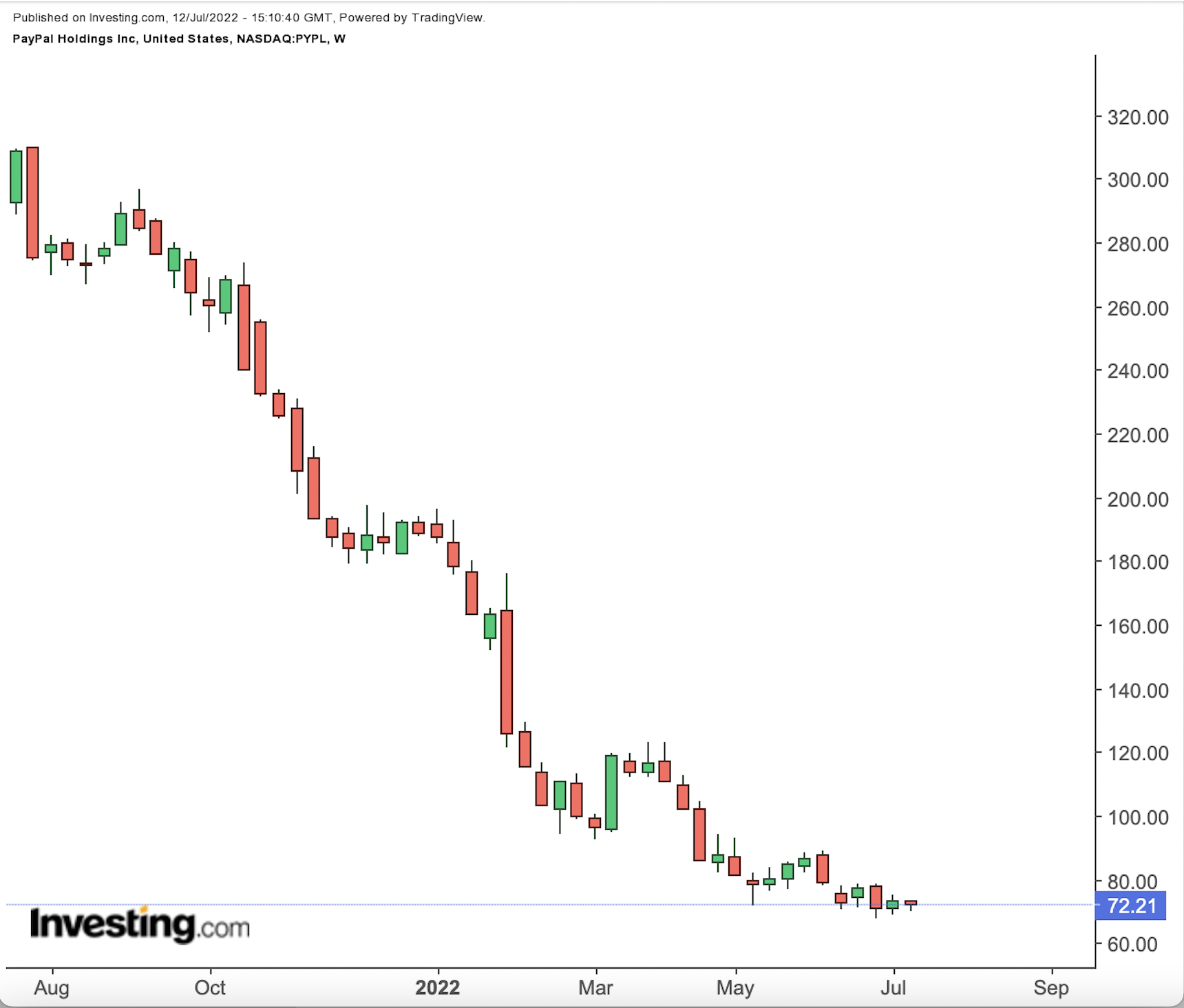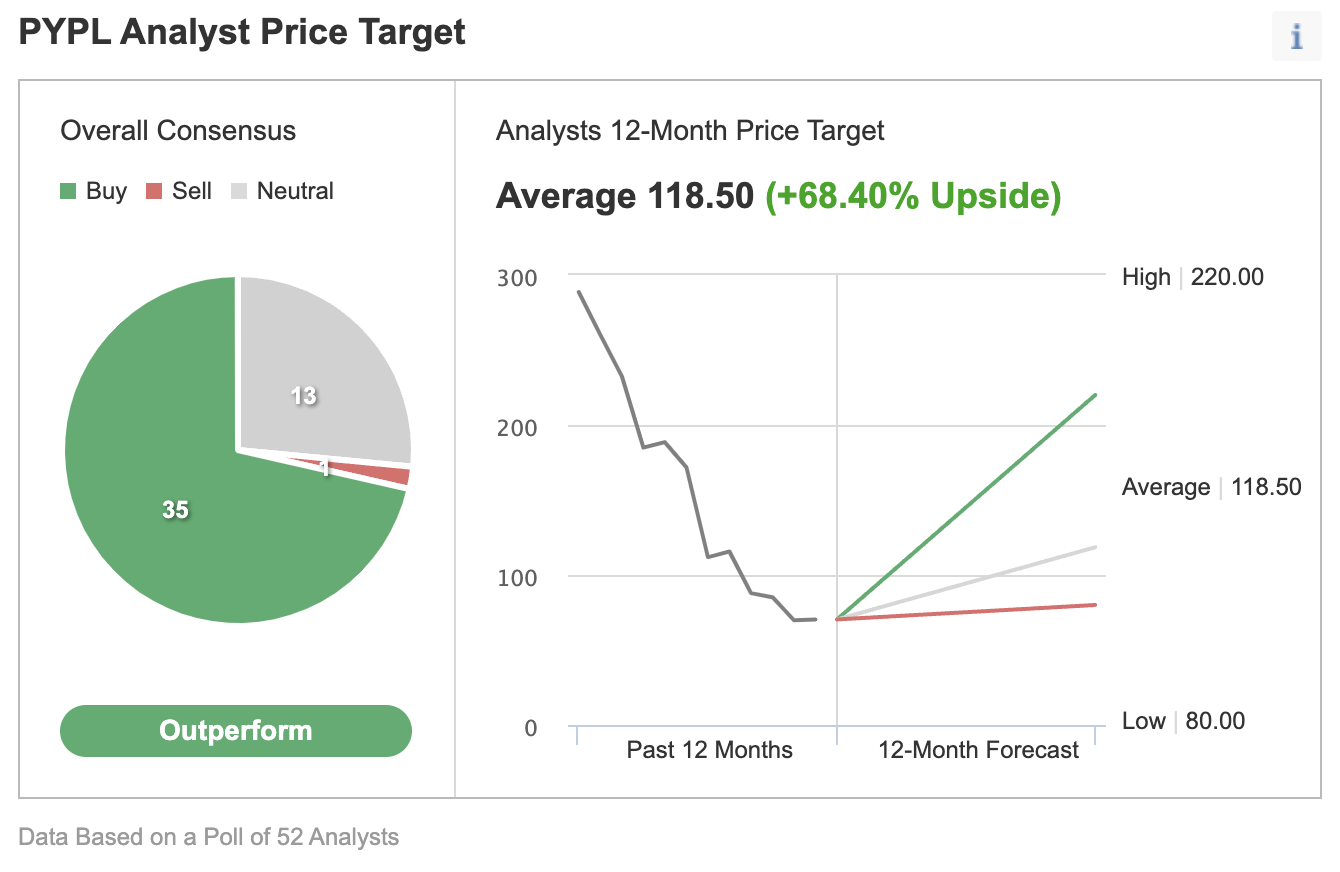Qantas shares slide to 6-mth low as airline trims revenue outlook
- Shares of online payment processor PayPal are down more than 60% since the start of 2022
- Collaborations with cash-back credit cards may attract more consumers
- Buy-and-hold investors could consider buying PYPL stock at current levels
Digital payments platform PayPal (NASDAQ:PYPL) facilitates mobile and online payments, serving about 430 million accounts globally. Its payment products include PayPal, PayPal Credit, Venmo, Hyperwallet, the buy-now-pay-later product Pay Monthly, and Braintree. Within the payment management segment, PayPal’s market share is around 32%.
PayPal shareholders have seen the value of their investment fall by 75% in the past 12 months and 61% so far this year. By comparison, Cathie Wood’s widely followed ARK Fintech Innovation ETF (NYSE:ARKF) plunged 57.7% so far this year. Meanwhile, shares of fintech rivals Affirm Holdings (NASDAQ:AFRM) and Block (NYSE:SQ) have also declined 76.8% and 58.5% so far in 2022.

Source: Investing.com
On July 26, 2021, PYPL shares went over $309 to hit an all-time high. However, shares have plunged to a multi-week low of $67.58 at the end of June this year, a decline of 78% from its peak value. The stock’s 52-week range has been $67.58 - $309.76. The market capitalization currently stands at $85 billion.
Recent Metrics
The fintech company released Q1 metrics on April 27. Revenue increased 8% to $6.5 billion year-over-year. However, adjusted earnings per share fell to 88 cents, down from $1.22 per share a year ago. Free cash flow of $1.1 billion declined 32% YoY. Cash and equivalents ended the period at $15.1 billion.
On the results, CEO Dan Schulman said:
“I’m pleased our first quarter results exceeded our guidance on revenue and earnings, and we continue to grow faster than the rate of e-commerce.”
For the second quarter, management forecasts net revenue to grow approximately 9%. Adjusted diluted EPS is expected to come in at 86 cents, down from $1.15 in the same period in the previous year.
While total payment volume grew 15% YoY to $323 billion during Q1, growth in new active users will likely decelerate through 2022. Management forecasts adding only 15 million to 20 million new active users in 2022—around a third of the growth in 2021. Therefore, Wall Street now expects the fintech giant to look for ways to better monetize its current user base.
Prior to the announcement of the first quarter metrics, PYPL stock was changing hands around $83. On July 11, it closed at $70.46. PayPal is expected to release Q2 figures on Aug. 2.
What To Expect From PYPL Stock
Among 52 analysts polled via Investing.com, PYPL stock has an "outperform" rating. Wall Street has a 12-month median price target of $118.50 for the stock, implying an increase of about 68.4% from the current price. The 12-month price range currently stands between $80 and $220.

Source: Investing.com
Similarly, according to a number of valuation models, like those that might consider P/E or P/S multiples or terminal values, the average fair value for PYPL stock on InvestingPro stands at $108.47.

Source: InvestingPro
In other words, fundamental valuation suggests shares could increase by more than 54%.
As part of the short-term sentiment analysis, it would be important to look at the implied volatility levels for PYPL options as well. Implied volatility typically shows traders the market's opinion of potential moves in a security, but it does not forecast the direction of the move.
PayPal’s current implied volatility is about 5% higher than the 20-day moving average. In other words, implied volatility is trending higher, while options markets suggest increased choppiness ahead, especially as the Q2 reporting period approaches.
Our expectation is for PayPal stock to build a base between $70 and $75 in the coming weeks. Afterwards, PYPL shares could potentially start a new leg up.
Adding PYPL Stock To Portfolios
PayPal bulls who are not concerned about short-term volatility could consider investing now. Their target price would be $118.50, as per the target provided by various quantitative models.
Alternatively, investors could consider buying an exchange-traded fund (ETF) that has PYPL stock as a holding. Examples include:
- Grayscale Future of Finance ETF (NYSE:GFOF)
- ETFMG Prime Mobile Payments ETF (NYSE:IPAY)
- Invesco NASDAQ Internet ETF (NASDAQ:PNQI)
- Capital Link Global Fintech Leaders ETF (NYSE:KOIN)
Finally, investors who expect PYPL stock to bounce back in the weeks ahead could consider setting up a covered call.
Most option strategies are not suitable for all retail investors. Therefore, the following discussion on PYPL stock is offered for educational purposes and not as an actual strategy to be followed by the average retail investor.
Covered Call On PYPL Stock
Price At Time Of Writing: $73.43
For every 100 shares held, the covered call strategy requires the trader to sell one call option with an expiration date at some time in the future.
Investors who believe there could still be short-term declines might use a slightly in-the-money (ITM) covered call. A call option is ITM if the market price (here, $73.43) is above the strike price ($72.50).
So, the investor would buy (or already own) 100 shares of PYPL stock at $73.43 and, at the same time, sell a PYPL Sept. 16 $72.50-strike call option. This option is currently offered at a price (or premium) of $8.30.
An option buyer would have to pay $8.30 X 100 (or $830) in premium to the option seller. This call option will stop trading on Friday, Sept. 16.
Assuming a trader would now enter this covered call trade at the current price, at expiration, the maximum return would be $737 ($830 - ($73.43 - $72.50) X 100), excluding trading commissions and costs.
The trader realizes this gain of $737 as long as the price of PYPL stock at expiry remains above the strike price of the call option (i.e., $72.50 here).
At expiration, this trade would break even at the PYPL stock price of $65.13 (i.e., $73.43 -$8.30), excluding trading commissions and costs.
On Sept. 16, if PYPL stock closes below $65.13, the trade would start losing money within this covered call set-up. Therefore, by selling this covered call, the investor has some protection against a potential loss. In theory, a stock's price could drop to $0.
As we have noted in numerous articles, a covered call limits the upside profit potential in PayPal shares. The risk of not participating in PYPL stock's potential appreciation fully would not appeal to everyone. However, within their risk/return profiles, others might find that acceptable in exchange for the premium received.
Disclosure: Tezcan Gecgil, Ph.D., does not have any positions in the securities mentioned in this article.
